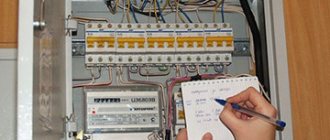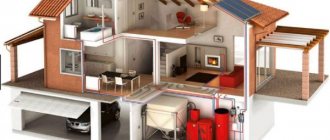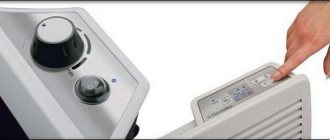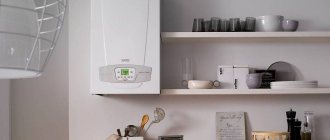- December 6, 2020
- Electricity
- Yulia Tolok
Every owner should know how to calculate electricity (calculate its consumption, in other words). In this case, electricity consumption refers to the amount of electrical energy that devices use to operate. You need to know its consumption in order to assess your purchasing power, avoid making mistakes when paying, and also evaluate what measures can be taken to improve energy efficiency and where you can save.
The total consumption of all devices that are connected to the network can be calculated using an individual meter. He will also answer the question of how to calculate the payment for electricity. A slightly more complicated situation is to calculate the consumption of an individual device.
Characteristics of electric current
The device passport may indicate various characteristics indicating its consumption, but most often these are supply voltage, current or power (usually at maximum load). Often the voltage is omitted, since it means that all goods produced on the territory of the Russian Federation or imported here are designed for a voltage of 220 V. In the USA, this parameter is 110-120 V.
From school physics courses, many remember that current is measured in amperes, voltage in volts, and power in watts. It is necessary to note that for more powerful devices the latter can be indicated in kilowatts, which are proportional to one thousand watts.
Sometimes the device's passport indicates electricity consumption, not power. It is important to pay attention to the period for which it is indicated; it could be a year, a month, a day, and so on. Electricity is paid in kW-hours, which is indicated as kWh. There is a common notation kW/hour or “kilowatt per hour”, which is incorrect when it comes to electricity consumed. In fact, these units measure the speed of construction of power plants. Sometimes a multiple of it, mW/year, is also found.
Calculation options
Ohm's law connects these three parameters, which we need to calculate electrical power. Let's look at three possible calculation options:
- The current and voltage are known.
- The current and resistance are known.
- The resistance and voltage are known.
Power is equal to the product of voltage and current. Accordingly, if we know these two quantities, we simply need to multiply them. For example, the current in a circuit is 10 amperes and the voltage is 200 volts. Accordingly, the power is 2 thousand watts.
If we know the resistance and current , then the formula will be slightly different. First let's find the voltage. To do this, you need to multiply the current and resistance. After this, the result must be multiplied by the current. Accordingly, in this case, the voltage is equal to the product of resistance and current squared. For example, the resistance is 50 ohms and the current is 10 amperes. We need to multiply 50 by 10, and then again by 10. We get a result equal to 5 thousand watts.
In the case of known voltage and resistance, we will have to resort to division. According to Ohm's law, current is equal to the quotient of voltage and resistance. Accordingly, in this case, power is equal to voltage squared divided by resistance. For example, the voltage in a circuit is 100 volts and the resistance is 50 ohms. We need to raise 100 to the second power, and then divide the resulting number by 50. We get a result equal to 200 watts.
Electricity meter
Electric meters today are found in almost every apartment or house. They help you pay exactly how much electricity is consumed and, if necessary, save it.
Previously, all electricity meters were mechanical. Their display looked like rotating drums with numbers that showed the amount of electricity consumed. Now this is a digital display with many additional functions, such as dividing consumption into tariff zones, calculating average consumption, indicating the presence of current in the network, and so on.
Using a meter, you can calculate the electricity consumption of a specific device. To do this, you need to turn off all other equipment in the house and leave only the one that interests you. Record the time, for example an hour. And see how many kW*hours the meter will “wind up”. If you calculate the time over a shorter period of time, then you should multiply these meter readings by the desired coefficient.
It should be noted that most devices consume less than 1 kWh. In this case, you should pay attention to the last digit, which is highlighted in red or after the decimal point. These are tenths. If you take them into account, the indicator will be more accurate.
Not all equipment constantly consumes the amount of electricity indicated in the passport. Depending on the operating mode, this number is usually lower. The refrigerator freezes only when the temperature rises above a predetermined interval, and the washing machine consumes more if the heating elements or pump are turned on, but is practically idle when the laundry is soaking. Energy consumption is calculated based on the power of each device and their total.
What formula is used to determine one-time tax from January 1, 2022?
Electricity spent on general household needs is calculated in two ways:
- According to the readings of the metering devices installed in the apartment building.
- According to generally accepted standards that are established by regional or local authorities.
The first option is often more economical and therefore more profitable for residents. The presence of meters simplifies the calculation process. At the end of the months, the responsible employee takes readings from the common building meter and subtracts from it the kilowatts consumed by each apartment separately. As a result, the number of kilowatts spent on the operation of the elevator, lighting in the entrances and other needs is calculated.
The formula for calculating electricity ONE for each individual apartment is as follows:
(OP – SP) * DP = IO , where:
- OP – general house consumption indicator;
- SP - the amount of electricity consumption for all individual metering devices (this includes apartments without meters);
- DP – the share of the apartment’s area from the total area of all apartments;
- IO is the final indicator of payment for an apartment.
DP is calculated using the formula:
OPK / SP , where:
- OPK – total area of the payer’s apartment;
- SP – the total area of all apartments in an apartment building.
Let's look at an example: There are 100 apartments in an apartment building with the same area of 50 sq.m. Each of them consumed 150 kW per month. The total electricity consumption was 17,000 kW.
Let's do the calculation: (17000 – 15000) * (50/5000) = 20 kW.
One apartment will be charged for 20 kW spent on ODN.
Calculation rates are individual.
Read about the average electricity consumption in an apartment per month here.
Calculation of power of electrical appliances
Determining the power of equipment is useful not only for calculating the energy consumed and saving it. It also helps to estimate the maximum load, and prevent fire if this number is exceeded.
Most device data sheets indicate power. If you multiply the indicated number in kW by the operating time, you can get the amount of electricity consumed. Next, it remains to figure out how to calculate electricity consumption based on the power of the equipment.
Let's say there are 2 light bulbs of 40 W each and a kettle with a power of 2.1 kW. The light bulbs work for 4 hours a day, and the kettle boils for 5 minutes. Let's say it is used 6 times a day. Then the light bulbs consume 320 W hours, and the kettle - 1.05 kW. The total consumption will be 1.37 kW.
Converting amperes to kilowatts
In some cases, only one number may be indicated in the passport or on the device itself - current (amps). To get watts from this parameter, simply multiply it by voltage. If the voltage is not specified, then the value is 220 V (for devices designed for operation in Europe or Russia). This calculation method will be correct for most household electrical appliances.
It's worth noting that when you multiply volts by amps, you get watts, not kilowatts. To find out the value of the latter, you need to divide the resulting value by 1000.
What is power consumption?
Power consumption is a numerical measure of the amount of electrical energy required for the operation of an electrical appliance or converted by it during operation. For static devices (stove, iron, TV, lighting), current energy turns into heat during operation). During conversion (electric motors), the energy of electric current is converted into mechanical energy.
The basic unit of electrical power is Watt, its numerical value
where U is voltage, Volts, I is current, amperes.
Sometimes this parameter is indicated in V×A (V×A for imported equipment), which is more correct for alternating current. The difference between Watts and VA for household networks is small and can be ignored.
Electrical power consumption is important when planning wiring (the cross-section of the wires depends on it, as well as the choice of ratings and the number of circuit breakers). During operation, it determines the costs of maintaining the home.
Measuring consumption by the device
It will not be possible to find out exactly the real consumption using only the formula. You can use an electricity meter in principle. But the most convenient option is a special meter for the outlet. It is quite common and often found on sale; you can find it by its name - energy meter, or wattmeter.
Using such a measuring device, you can obtain the following data:
- cost of electricity consumption per month when setting tariffs;
- voltage and current at the moment;
- current power;
- consumption for a given period of time.
To start measuring, just plug the wattmeter into a power outlet. It also has a socket. The measuring devices are connected there. Once connected, power, voltage, current, consumption and other indicators will be displayed in real time, depending on the settings.
How much electricity do household appliances consume?
Electricity consumption of household appliances
It is convenient to calculate in thousands of watts (kW) per unit time interval (hour), abbreviated kW/h. Multiplication determines consumption per day, month or year. Special standards are developed based on the noted indicators. These parameters are used to determine whether the economy meets modern standards.
For example, for dishwashers, classes from D to A+++ are established for electrical energy consumption. Similar criteria have been created for other popular household appliances.
Much will depend on the operating mode. Taking into account the average amount of time, you can find out how much a specific boiler room as a whole or a separate model of household appliances will consume per month. The same parameter will help calculate the resource for replacing consumables and performing routine operations.
Computer
The main source of consumption is the system unit. It has a power supply installed, and once you know its power characteristics, you can estimate the approximate consumption. As a rule, this is 300-600 W. But this is the maximum power; it is unlikely that the computer will only consume even under full load.
Additionally, you need to take into account the monitor and other equipment, if it is turned on (printer, scanner, modem, speakers). In total, for an average computer, consumption is about 550 W (0.55 kW). But taking into account downtime and performing simple tasks, the average value is taken - 0.5 kW. It turns out that if you use a computer for 6 hours a day, then it consumes about 90 kWh per month. Accordingly, if the computer does not turn off around the clock, then its maximum monthly consumption will exceed 300 kWh.
Fridge
According to the technical data sheet of most refrigerators, they consume about 230-450 kWh per year. It is enough to divide this number by 12 to get a monthly consumption of about 20-30 kW. It will vary depending on the size of the refrigerator, the presence of a freezer, the density of the rubber bands, the presence of energy-saving modes and the food load. Also, to assess consumption, it is necessary to take into account external conditions. It will directly depend on the air temperature in the room.
TV
Consumption by TVs differs depending on their design and screen diagonal. So, for example, on average a small TV will “eat” 100 W, while a plasma with a large diagonal will already consume 300 W or even 500 W. You also need to take into account the time you watch TV, whether any additional devices are used (for example, receivers) and how many TVs are installed in the apartment. It is estimated that if the TV is turned on for about 4 hours a day, it consumes approximately 20-30 kWh monthly.
Washing machine
The consumption of a washing machine is usually specified in the passport. The numbers depend on the program and are indicated not for hourly consumption, but for the entire cycle. The power of an average device is 2-2.5 kW; in practice, 1.5 kW*hour is consumed per hour. When using a washing machine twice a week with a 2-hour cycle, you get about 20 kWh.
However, this figure will be higher if the washing machine has a drying mode, the family is large or there are small children.
Direct current measurement
The methods of that group are characterized by higher accuracy due to the fact that they are based on direct measurement of current. There are two devices for performing this procedure at home.
Metering with current clamps
The most convenient to use are current clamps that do not require breaking the controlled circuit. Designed as a hand-held device with a measuring unit based on a toroidal core. To measure the current, the assembly is opened in the manner of pincer sponges, and then closed to cover the wire, Figure 3. The effective value of the current is determined by the change in the magnetic field, which is recorded by the Hall sensor.
Measurement with a tester
The second method is based on the use of a tester, which is switched to ammeter mode and connected to an open circuit. The difficulties of implementing this procedure using simple means make it little popular in practice. We also cannot discount the fact that some tester models do not have current protection and fail (burn out) if the range is incorrectly selected (current overload).
Kettle and iron
These devices are considered the most expensive in terms of energy costs. Despite the fact that they do not work for long, the consumption for both devices is still about 30 kWh per month.
Not all appliances that consume electricity in the house are listed. Additionally, you will need to count such things as a multicooker, microwave oven, vacuum cleaner, phone chargers and others, if available. Maximum consumption is observed if an electric or induction stove, air conditioner, boiler or electric heaters are used.
Warm floor
This type of heating is considered one of the most economical, even if electricity is used for heating. However, consumption depends on many factors, such as operating mode, desired air temperature in the room, outdoor air temperature, types of coatings, and so on. It is believed that if a heated floor is used instead of the main heating device, then it consumes about 0.2 kW per 1 sq.m. per hour. m. If it is used only to maintain a comfortable temperature, in the presence of other heat sources, then this figure will be approximately half as much. In order to calculate the monthly consumption, it is necessary to multiply this figure by the heated area, daily operating time and the number of days in the month.
Cost of electricity consumption
To estimate the amount you will have to pay for electricity, you need to know the average cost for your region of residence. Let’s say this figure is 4 rubles per kW*hour.
Next, you should multiply the resulting number (from the monthly meter) by the price. For example: consuming 100 kWh of electricity per month will cost 400 rubles.
There are many online calculators that can help you calculate this figure more accurately. The cost may depend on some other criteria: the presence of a multi-tariff meter, benefits, total monthly consumption, and so on.
Methods for calculating average energy consumption
You can calculate the electricity consumption using different methods.
- Taking the annual meter readings and calculating the average monthly consumption based on the obtained value.
- By power, current, voltage of each household appliance.
Calculations can be made using online calculators. The program will perform all the necessary calculations and help develop a system for optimizing electricity waste.
To calculate electricity from the meter, the kW-hours indicated in the previous readings must be subtracted from the current meter value, without taking into account the decimal number.
Energy Saving Tips
Having analyzed energy costs, many owners involuntarily wonder if it is possible to somehow reduce them? Typically, large consumption is affected by refrigerators and lamps.
To reduce the consumption of a refrigerator, it must be moved away from the wall so that it is better ventilated, or replaced with a new one with better consumption readings.
It is optimal to use energy-saving light bulbs. They come in two types: LED and mercury. The latter are cheaper, but less durable, have lower efficiency and require special disposal rules. LED lamps are the best option. Provided they are made with high quality, they last a long time, can be produced in different colors, adjustable power, and as a rule, the manufacturer gives them a long warranty.
Tariffs depending on the time of day
Since energy consumption drops significantly at night, which complicates the operation of power plants, programs have been developed that allow you to pay less during the least busy period. This was done so that when installing a two- or three-tariff meter, people would use some of their electrical appliances at night and save money, while the load on the networks would be distributed more evenly.
In most regions there are two- or multi- (most often three-) tariff zones. In the first case (2-tariff zones), the cost of electricity at night falls by 2 times compared to the standard tariff. In the second, three tariff zones are distinguished. The first is night with a coefficient of 0.4. The second is half-peak with a coefficient of 1. The third is peak, with a coefficient of 1.5. Thus, for consumption in the night zone you need to pay 40% of the standard tariff, and in the peak zone - one and a half times more.
To use this type of tariffing, special electronic meters are required, in which meter readings are given separately for each zone. Some of them send the received data to the controller automatically, and, accordingly, the correct payment is received without the need to enter readings manually.
In order to understand how to calculate metered electricity consumed according to the principle of several tariffs, it is necessary to take the values for each tariff zone, multiply them by the standard tariff and by the normalization coefficient. The amount of consumption for all tariffs must be equal to the total consumption, which is also indicated on the meter.
The latter helps ensure that the calculations are made correctly.
How to reduce your consumption
The electricity consumption calculator helps create a sound basis for developing an action program. Regular costs can be reduced using a set of special measures. The first step is to check the individual operating modes in detail. Setting an optimal switching schedule will help to rationally use street lamps in private households. They optimize operating time using a light-sensitive sensor that is set to a certain level of darkness. It is necessary to exclude the “background” operation of the TV and other habits harmful to the home budget.
To get good results, use the following recommendations:
- replace classic incandescent lamps with LED devices (consumption is reduced by 7-9 times);
- for boiling, pour in a dosed amount of liquid;
- reduce the time it takes for computers, laptops, and mobile devices to go into sleep mode;
- improve the thermal insulation parameters of premises;
- use screens that reflect infrared radiation towards the room;
- defrost the refrigerator, clean boilers from scale and other routine operations in a timely manner to maintain good equipment efficiency indicators.
Certain types of equipment (with significant consumption) are considered especially carefully. The washing machine is used in economical modes, with the maximum possible load. The oven is not preheated; it is turned off 10-15 minutes beforehand. until cooking is complete. The air conditioner maintains a temperature sufficient for comfort, but not too low. In any case, when checking current market offers, you should pay attention to modern models of equipment with improved electricity consumption indicators. A slight increase in the initial investment will pay off many times over during operation.











